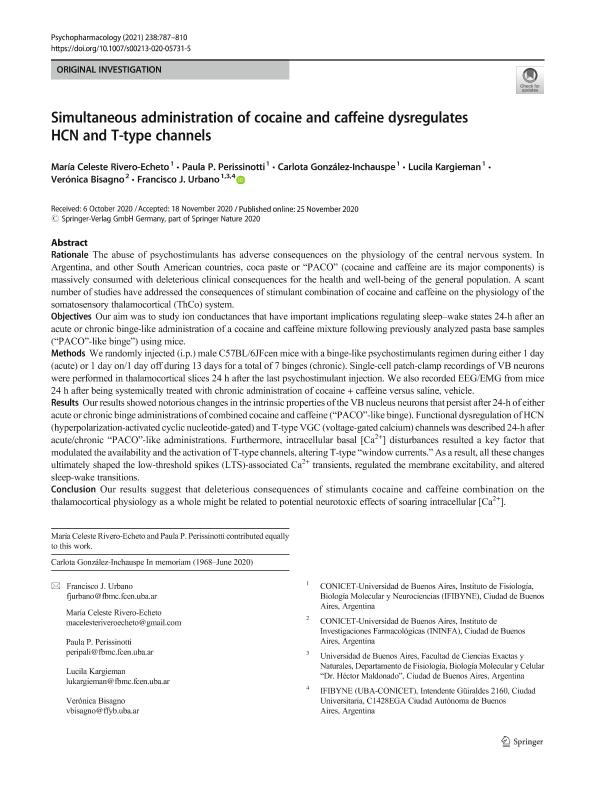Artículo
Simultaneous administration of cocaine and caffeine dysregulates HCN and T-type channels
Rivero Echeto, Maria Celeste Solange ; Perissinotti, Paula Patricia
; Perissinotti, Paula Patricia ; González Inchauspe, Carlota María Fabiola
; González Inchauspe, Carlota María Fabiola ; Kargieman, Lucila
; Kargieman, Lucila ; Bisagno, Veronica
; Bisagno, Veronica ; Urbano Suarez, Francisco Jose
; Urbano Suarez, Francisco Jose
 ; Perissinotti, Paula Patricia
; Perissinotti, Paula Patricia ; González Inchauspe, Carlota María Fabiola
; González Inchauspe, Carlota María Fabiola ; Kargieman, Lucila
; Kargieman, Lucila ; Bisagno, Veronica
; Bisagno, Veronica ; Urbano Suarez, Francisco Jose
; Urbano Suarez, Francisco Jose
Fecha de publicación:
03/2021
Editorial:
Springer
Revista:
Psychopharmacology
ISSN:
0033-3158
Idioma:
Inglés
Tipo de recurso:
Artículo publicado
Clasificación temática:
Resumen
Rationale: The abuse of psychostimulants has adverse consequences on the physiology of the central nervous system. In Argentina, and other South American countries, coca paste or “PACO” (cocaine and caffeine are its major components) is massively consumed with deleterious clinical consequences for the health and well-being of the general population. A scant number of studies have addressed the consequences of stimulant combination of cocaine and caffeine on the physiology of the somatosensory thalamocortical (ThCo) system. Objectives: Our aim was to study ion conductances that have important implications regulating sleep–wake states 24-h after an acute or chronic binge-like administration of a cocaine and caffeine mixture following previously analyzed pasta base samples (“PACO”-like binge”) using mice. Methods: We randomly injected (i.p.) male C57BL/6JFcen mice with a binge-like psychostimulants regimen during either 1 day (acute) or 1 day on/1 day off during 13 days for a total of 7 binges (chronic). Single-cell patch-clamp recordings of VB neurons were performed in thalamocortical slices 24 h after the last psychostimulant injection. We also recorded EEG/EMG from mice 24 h after being systemically treated with chronic administration of cocaine + caffeine versus saline, vehicle. Results: Our results showed notorious changes in the intrinsic properties of the VB nucleus neurons that persist after 24-h of either acute or chronic binge administrations of combined cocaine and caffeine (“PACO”-like binge). Functional dysregulation of HCN (hyperpolarization-activated cyclic nucleotide-gated) and T-type VGC (voltage-gated calcium) channels was described 24-h after acute/chronic “PACO”-like administrations. Furthermore, intracellular basal [Ca2+] disturbances resulted a key factor that modulated the availability and the activation of T-type channels, altering T-type “window currents.” As a result, all these changes ultimately shaped the low-threshold spikes (LTS)-associated Ca2+ transients, regulated the membrane excitability, and altered sleep-wake transitions. Conclusion: Our results suggest that deleterious consequences of stimulants cocaine and caffeine combination on the thalamocortical physiology as a whole might be related to potential neurotoxic effects of soaring intracellular [Ca2+].
Palabras clave:
HCN channels
,
T-type channels
,
cocaine
,
caffeine
Archivos asociados
Licencia
Identificadores
Colecciones
Articulos(IFIBYNE)
Articulos de INST.DE FISIOL., BIOL.MOLECULAR Y NEUROCIENCIAS
Articulos de INST.DE FISIOL., BIOL.MOLECULAR Y NEUROCIENCIAS
Articulos(ININFA)
Articulos de INST.DE INVEST.FARMACOLOGICAS (I)
Articulos de INST.DE INVEST.FARMACOLOGICAS (I)
Citación
Rivero Echeto, Maria Celeste Solange; Perissinotti, Paula Patricia; González Inchauspe, Carlota María Fabiola; Kargieman, Lucila; Bisagno, Veronica; et al.; Simultaneous administration of cocaine and caffeine dysregulates HCN and T-type channels; Springer; Psychopharmacology; 238; 3; 3-2021; 787-810
Compartir
Altmétricas



